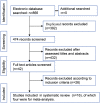Efficacy and Safety of Hypofractionated Radiotherapy for the Treatment of Newly Diagnosed Glioblastoma Multiforme: A Systematic Review and Meta-Analysis
- PMID: 31681570
- PMCID: PMC6802705
- DOI: 10.3389/fonc.2019.01017
Efficacy and Safety of Hypofractionated Radiotherapy for the Treatment of Newly Diagnosed Glioblastoma Multiforme: A Systematic Review and Meta-Analysis
Abstract
Background: Hypofractionated radiotherapy (HFR) is sometimes used in the treatment of glioblastoma multiforme (GBM). The efficacy and safety of HFR is still under investigation. The aim of this systematic review and meta-analysis was to provide a comprehensive summary of the efficacy and safety of HFR, and to compare the efficacy and safety of HFR and conventional fraction radiotherapy (CFR) for the treatment of patients with GBM, based on the results of randomized controlled trials (RCTs). Methods: A literature search was conducted to identify Phase II and III trials o comparing the efficacy and safety of HFR and CFR. Study selection, data extraction, and quality assessment, were conducted by two independent researchers. The analysis was performed using RevMan 5.3 and Stata 12.0. Results: Sixteen Phase II and III trials were included in the systematic review, and four RCTs were included in the meta-analysis. Participants treated with HRF and CRF had comparable overall survival (OS) (hazard ratio [HR]: 0.94, 95% confidence interval [CI]: 0.72-1.22, P = 0.64) and progression-free survival (PFS) (HR: 1.09, 95% CI: 0.60-1.95, P = 0.79), and similar rates of adverse events. However, in participants aged >70 years, those who received HFR had a higher OS than those who received CFR (HR: 0.59, 95% CI: 0.37-0.93, P = 0.02). Conclusions: HRF is efficacious and safe for the treatment of GBM. In individuals aged >70 years, treatment with HRF is superior to CFR in terms of OS. The role of HFR in the treatment of GBM in younger individuals and those with good prognostic factors requires further research.
Keywords: brain tumors; conventional fraction radiotherapy; glioblastoma multiforme; gliomas; hypofractionated radiotherapy; radiochemotherapy.
Copyright © 2019 Liao, Zhao, Yang and Li.
Figures






Similar articles
-
Hypofractionated accelerated radiotherapy (HART) with concurrent and adjuvant temozolomide in newly diagnosed glioblastoma: a phase II randomized trial (HART-GBM trial).J Neurooncol. 2018 Oct;140(1):75-82. doi: 10.1007/s11060-018-2932-3. Epub 2018 Jun 23. J Neurooncol. 2018. PMID: 29936695 Clinical Trial.
-
Progression-Free but No Overall Survival Benefit for Adult Patients with Bevacizumab Therapy for the Treatment of Newly Diagnosed Glioblastoma: A Systematic Review and Meta-Analysis.Cancers (Basel). 2019 Nov 4;11(11):1723. doi: 10.3390/cancers11111723. Cancers (Basel). 2019. PMID: 31689995 Free PMC article. Review.
-
Efficacy of moderately hypofractionated simultaneous integrated boost intensity-modulated radiotherapy combined with temozolomide for the postoperative treatment of glioblastoma multiforme: a single-institution experience.Radiat Oncol. 2019 Jun 13;14(1):104. doi: 10.1186/s13014-019-1305-1. Radiat Oncol. 2019. PMID: 31196126 Free PMC article. Clinical Trial.
-
The role of Gliadel wafers in the treatment of newly diagnosed GBM: a meta-analysis.Drug Des Devel Ther. 2015 Jun 29;9:3341-8. doi: 10.2147/DDDT.S85943. eCollection 2015. Drug Des Devel Ther. 2015. PMID: 26170620 Free PMC article. Review.
-
Hypofractionated Radiotherapy in Combination With Chemotherapy Improves Outcome of Patients With Esophageal Carcinoma Tracheoesophageal Groove Lymph Node Metastasis.Front Oncol. 2020 Aug 28;10:1540. doi: 10.3389/fonc.2020.01540. eCollection 2020. Front Oncol. 2020. PMID: 32984011 Free PMC article.
Cited by
-
FLASH Radiotherapy: A FLASHing Idea to Preserve Neurocognitive Function.Brain Tumor Res Treat. 2023 Oct;11(4):223-231. doi: 10.14791/btrt.2023.0026. Brain Tumor Res Treat. 2023. PMID: 37953445 Free PMC article. Review.
-
The minimal FLASH sparing effect needed to compensate the increase of radiobiological damage due to hypofractionation for late-reacting tissues.Med Phys. 2022 Dec;49(12):7672-7682. doi: 10.1002/mp.15911. Epub 2022 Aug 19. Med Phys. 2022. PMID: 35933554 Free PMC article.
-
Neuro-oncology Management During the COVID-19 Pandemic With a Focus on WHO Grade III and IV Gliomas.Neuro Oncol. 2020 May 5;22(7):928-35. doi: 10.1093/neuonc/noaa113. Online ahead of print. Neuro Oncol. 2020. PMID: 32369601 Free PMC article.
-
Single-dose radiotherapy is more effective than fractionation when combined with anti-PD-1 immunotherapy in glioblastoma.Sci Rep. 2025 Jul 2;15(1):22910. doi: 10.1038/s41598-025-06909-7. Sci Rep. 2025. PMID: 40596223 Free PMC article.
-
Accelerated hyper-versus normofractionated radiochemotherapy with temozolomide in patients with glioblastoma: a multicenter retrospective analysis.J Neurooncol. 2022 Jan;156(2):407-417. doi: 10.1007/s11060-021-03926-0. Epub 2021 Dec 23. J Neurooncol. 2022. PMID: 34940951 Free PMC article.
References
-
- Stupp R, Hegi ME, Mason WP, van den Bent MJ, Taphoorn MJ, Janzer RC, et al. . Effects of radiotherapy with concomitant and adjuvant temozolomide versus radiotherapy alone on survival in glioblastoma in a randomised phase III study: 5-year analysis of the EORTC-NCIC trial. Lancet Oncol. (2009) 10:459–66. 10.1016/S1470-2045(09)70025-7 - DOI - PubMed
-
- Carlson JA, Reddy K, Gaspar LE, Ney D, Kavanagh BD, Damek D, et al. . Hypofractionated-intensity modulated radiotherapy (hypo-IMRT) and temozolomide (TMZ) with or without bevacizumab (BEV) for newly diagnosed glioblastoma multiforme (GBM): a comparison of two prospective phase II trials. J Neurooncol. (2015) 123:251–57. 10.1007/s11060-015-1791-4 - DOI - PubMed
Publication types
LinkOut - more resources
Full Text Sources
Medical

